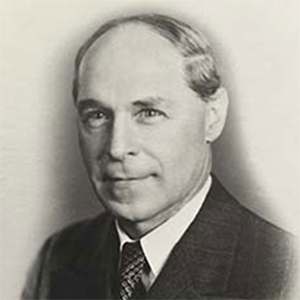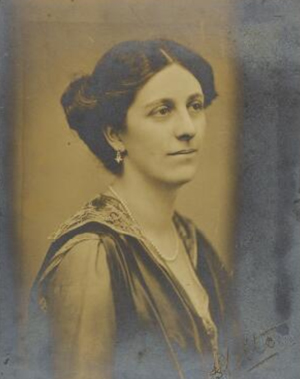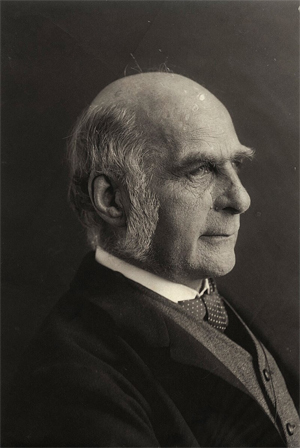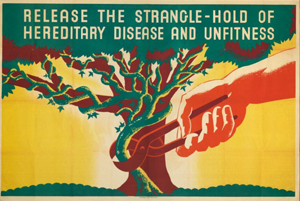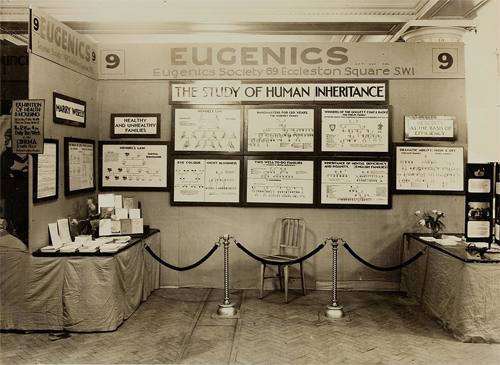by Wikipedia
Accessed: 4/1/20
On January 17, 1945, as the Russian army approached Auschwitz, Mengele went from office to office methodically gathering his research materials. "He came into my office without a word," recounted pathologist Martina Puzyna. "He took all my papers, put them into two boxes, and had them taken outside to a waiting car." Mengele and the documents fled first to Gross-Rosen concentration camp, and then into Czechoslovakia. There he joined up with Hans Kahler, a close friend, coauthor and one of Verschuer's twins researchers. The Russians liberated Auschwitz on January 27, at about 3 P.M., and Mengele's horrors were quickly discovered. International commissions listed him as a war criminal. But Mengele slipped through the Allied manhunt and eventually escaped to South America. [1]
Even as the Allies closed in, Verschuer still hoped he and Hitler's Reich would prevail in its war against the Jews. Just months before Mengele abandoned Auschwitz, Verschuer published part of a lecture proclaiming, "The present war is also called a war of races when one considers the fight with World Jewry .... The political demand of our time is the new total solution [Gesamtlosung] of the Jewish problem." By the beginning of 1945, the Reich was collapsing. On February 15,1945, amid the chaos of Berlin's last stand, Verschuer found two trucks with which to ship his lab equipment, library, and several boxes of records to his family home in Solz. [2]
Nazi eugenicists continued their cover-up, in progress since the Normandy invasion. On March 12, 1945, Hans Nachtsheim, assistant director at the Institute for Anthropology, Human Heredity and Eugenics, wrote Verschuer in Solz. "A mass of documents have been left here which should be or have to be destroyed should the enemy ever come close to here .... We should not choose a moment ... too late to destroy them." [3] In the first days of May, the Reich was reduced to rubble and der Fuhrer had killed himself. [4] Nazism and its eugenics were defeated. But now its architects and adherents would reinvent its past.
In April of 1946, the military occupation newspaper in Berlin, Die Neue Zeitung, published an article on various doctors who had fled Germany, and followed it up on May 3 with specific accusations against Verschuer. In the article, Robert Havemann, a communist and chemist who had resisted the Nazis, expressed out loud what many knew. He openly accused Verschuer of using Mengele in Auschwitz to obtain blood samples and eyeballs from whole murdered families. [5]
A nervous Verschuer reacted at once. He sent a sworn statement to Otto Hahn, the occupation-appointed administrator of the Kaiser Wilhelm Institutes, insisting that he had always opposed racial concepts. "Even before 1933," averred Verschuer, "but also after, I took personal risks and attacked, as a scientist, in speeches and in writing, the race concept of the Nazis .... I argued against attributing values to races, I warned against the high estimation of the Nordic race, and I condemned the misuse of the results of anthropology and genetics to support a materialistic and racial point of view of life and history." [6]
He went on to concede his relationship with Mengele, referring to him only as "Dr. M.," and insisting it was totally innocent. Verschuer stated, "A post-doc of my former Frankfurt Institute, Dr. M., was sent against his will to the hospital of the concentration camp in Auschwitz. All who knew him learned from him how unhappy he was about this, and how he tried over and over again to be sent to the front, unfortunately without success. Of his work we learned that he tried to be a physician and help the sick.... [7]
"After I went to Berlin [from Frankfurt]," Verschuer continued, "I began research on the individual specificity of the serum proteins and the question of their heredity .... For these experiments I needed blood samples of people of different geographic background .... At that time my former post-doc Dr. M. visited me and offered to obtain such blood samples for me within the context of his medical activity in the camp Auschwitz. In this manner I received -- during this time, certainly not regularly -- a few parcels of 20-30 blood samples of 5-10 mls." [8]
Verschuer then asked Hahn to give him a character reference, and even drafted a statement for Hahn to sign: "Professor von Verschuer is an internationally known scientist who has kept away from all political activity .... Professor von Verschuer had nothing to do with the errors and misuses of the Nazis, by which his scientific field was particularly hit. He kept his distance from them and, whenever he was confronted by them, he criticized them courageously." Hahn would not sign such a document. [9]
So Verschuer sought support from his allies in American eugenics. Shortly after Havemann's expose, Verschuer wrote to Paul Popenoe in Los Angeles, hoping to reestablish cooperative ties. On July 25, Popenoe wrote back, "It was indeed a pleasure to hear from you again. I have been very anxious about my colleagues in Germany .... I suppose sterilization has been discontinued in Germany?" Popenoe offered tidbits about various American eugenic luminaries and then sent various eugenic publications. In a separate package, Popenoe sent some cocoa, coffee and other goodies. [10]
Verschuer wrote back, "Your very friendly letter of 7/25 gave me a great deal of pleasure and you have my heartfelt thanks for it. The letter builds another bridge between your and my scientific work; I hope that this bridge will never again collapse but rather make possible valuable mutual enrichment and stimulation." Seeking American bona fides, Verschuer tried to make sure his membership in the American Eugenics Society was still active. "In 1940, I was invited to become a member of the American Eugenics Society," Verschuer wrote. "Now that this calamitous war has ended, I hope that this membership can be continued. I would be grateful if you might make a gesture in this matter. In this context, I would like to mention that in recent months a former employee, a person devoid of character, has made extremely defamatory statements about me, which have also found their way into the American press. Therefore, it is possible that persons who do not know me better might have formed a wrong opinion of me. You will surely understand that it is important to me that any damage to my reputation be repaired and I would be very grateful for your kind help in doing so." [11]
Verschuer wrote again at the end of September 1946, requesting Popenoe's help. Because Verschuer was considered part of the Nazi medical murder apparatus, the Americans had halted his further work. "Since I wrote you," said Verschuer, "I have learned that the American military government does not intend to permit the continuation of my scientific work. This attitude can only be due to the spread of false information about me and my work. I have regularly sent you all of my scientific publications and you have known me for many years through correspondence. Therefore, may I ask for two things? 1. For a letter of recommendation from yourself and other American scientists who know me, stating that you know me as a serious scientific researcher and that you value my continued scientific work; 2. I ask you and other American geneticists and eugenicists who know me to undertake steps with the American military government in Germany to bring about the granting of permission for me to continue my life's work as a scientific researcher. It is my urgent wish that I be able to rebuild genetic and eugenic science from the ruins we stand upon in every area in Germany, a science that -- free of the misuse of past years -- may again attain international renown." [12]
Popenoe, who had also been corresponding with Lenz, was eager to be helpful, but uncomfortable standing up for an accused Nazi doctor. "I am distressed to hear that you may not be allowed to go ahead with your scientific work," Popenoe replied to Verschuer on November 7, 1946, "but it is hard for me to see how any of us over here could give any evidence that would be of value to you, even if we knew where to send it. Of course we could all testify that your scientific work before the war was objective and maintained very high standards. But if you have been 'denazified,' as I take to be the case from what you say, it was certainly not for that work, which is the only work I know about. None of us over here knows anything about what was going on in Germany from about 1939 onwards, but I suppose the action taken against you is due to your prominence in public life, as the successor of Eugen Fischer (who has been attacked bitterly in this country), etc. I could say nothing that would be pertinent, because I don't know anything about it. I am being perfectly frank with you, as you see .... But as it stands now, all I could say is: 'All his work that I saw before the war was of high quality,' and the authorities would presumably reply, 'That has nothing to do with it.''' [13]
Correspondence bounced back and forth between the two until Popenoe finally sent a brief letter of endorsement, limited to the prewar years. Verschuer then asked if he could be invited to join the faculty of an American university. "I have inquired from some leaders in American genetics," Popenoe replied, "and they all feel that it will be a long time before any university here is ready to offer a position to any German scientist who occupied an important position in Germany during the war years. As you perhaps know, our army brought over a number of physicists and other specialists, and their presence in this country has led to many protests and recriminations. I think it is out of the question, therefore, for you to look forward to any scientific activity here in the next few years -- much as I myself should like to have a visit from you." [14]
Throughout late 1947 and 1948, Verschuer continued corresponding with leading eugenicists and geneticists at American institutions, seeking to reestablish academic exchanges and professional standing. He submitted one of his older books for a new review by the American Eugenics Society. Popenoe promptly assured he would review it in a new eugenic publication called Family Life, and then bemoaned the loss of German eugenic publications. "It is sad to think," Popenoe wrote, "that the scientific journals, and even the publishing houses that produced them no longer exist!" Verschuer also began exchanges with scientists at the University of Michigan and the University of Minnesota. These were received with goodwill and even enthusiasm. When Nazi agitator C. M. [Charles Matthias] Goethe of California received Verschuer's letter, he replied that he was "thrilled." [15]
While Verschuer was busy reestablishing his support in America, he was rehabilitating himself in occupied Germany as well. After making his accusations public, Havemann organized a committee of Kaiser Wilhelm Institute scientists to examine the evidence against Verschuer. They ruled that Verschuer indeed had engaged in despicable acts in concert with Mengele at Auschwitz, but their report was kept secret for fifteen years. In 1949, while the first report remained under lock and key, a second board of inquiry was urged to reexamine the issue. This second board unanimously ruled that he had committed no transgressions involving Auschwitz, and indeed that "Verschuer has all the qualities which qualify him to be a researcher and teacher of academic youth." Virtually comparing Verschuer to Christ being crucified, the esteemed panel of German scientists declared they could not sit in judgment of him as "Pharisees" (Pharisaerhaft). [16]
Soon, Verschuer once again became a respected scientist in Germany and around the world. In 1949, he became a corresponding member of the newly formed American Society of Human Genetics, organized by American eugenicists and geneticists. Hermann Joseph Muller of Texas, a Rockefeller fellow who had worked at the Kaiser Wilhelm Institute for Brain Research during 1932, served as the first president of the American Society of Human Genetics. [17]
In the fall of 1950, the University of Munster offered Verschuer a position at its new Institute of Human Genetics, where he later became a dean. At about that time he helped found the Mainz Academy of Sciences and Literature, which later published his books, including one on cancer. In the early and mid-1950s, Verschuer became an honorary member of numerous prestigious societies, including the Italian Society of Genetics, the Anthropological Society of Vienna, and the Japanese Society for Human Genetics. [18]
A later president of the American Society of Human Genetics, Kurt Hirschhorn, remembered his own encounter with Verschuer in about 1958. An Austrian Jew, Hirschhorn had come to the United States as a refugee during the Hitler era. Hirschhorn became a genetic researcher and, while on a fellowship to Europe, he had visited Verschuer at the University of Munster. "Verschuer was partly responsible for the whole extermination," Hirschhorn related emphatically during a February 2003 interview. "He was the one that gave the Nazis the pseudo-genetic rationale to destroy the Jews and Gypsies. He was part of the organization [American Society of Human Genetics] in 1949 because in those days ... it was all covered up. No one really knew. But I'll never forget. I was sitting in his university office in Munster as a young man, and he asked a lot of personal questions about my background, and so forth, until he found out I was Jewish. I knew who he was by that time. I took a great deal of pleasure in telling him that I came to the United States from Austria, and when I turned eighteen, I enlisted in the army and went over there and fought the Nazis -- and went right through Munster. He was taken aback." [19]
In the 1960s, Frankfurt prosecutors were obliged by international pressure to continue their hunt for Nazis. The same prosecutors who investigated Mengele examined his relationship to Verschuer but concluded there was no connection between the two. Benno Muller-Hill, a German geneticist, later investigated Verschuer's activities. Muller-Hill reviewed Verschuer's many written defenses, including the one in which Verschuer claimed that while in Auschwitz, Mengele "tried to be a physician and help the sick." Writing in the journal History and Philosophy of Science, Muller-Hill described Verschuer's account as "Lies, lies, lies." [20]
Verschuer was never prosecuted. In 1969, he was killed in an automobile accident. But the legacy of his torturous medicine, twisted eugenics and conscious war crimes lives on.
***
As the ashes of Jews and Gypsies wafted into the air of Europe and were dumped into the Vistula River coursing through the heart of Europe, so their victimization flowed into the mainstream of modern medical literature. Medical literature evolves from decade to decade. As American eugenic pseudoscience thoroughly infused the scientific journals of the first three decades of the twentieth century, Nazi-era eugenics placed its unmistakable stamp on the medical literature of the twenties, thirties and forties.
The writings of Nazi doctors not only permeated the spectrum of German medical journals, they also appeared prominently in American medical literature. These writings included the results of war crime experimentation at concentration camps. Verschuer's own bibliographies, circa 1939, enumerated a long list of Nazi scientific discoveries, authored by him, his colleagues and assistants, including Mengele. Such scientific publication continued right through the last days of the Third Reich. The topics included everything from rheumatism, heart disease, eye pathology, blood studies, brain function, tuberculosis, and the gastric system to endless permutations of hereditary pathology. [21] Much of it was sham science. Some of it was astute. Both types found their way into the medical literature of the fifties and sixties. Hence, Nazi victimization contributed significantly to many of the modern medical advances of the postwar period.
For example, the Nazis at Dachau, using ice water tests, were the first to experimentally lower human body temperature to 79.7 degrees Fahrenheit -- this to discover the best means of reviving Luftwaffe pilots downed over the North Sea. Nazi scientists learned that the most effective method was rapid rewarming in hot water. Nuremberg testimony revealed that Dr. Sigmund Rascher, who oversaw these heinous hypothermia tests, prominently reported his breakthroughs at a 1942 medical symposium with a paper entitled "Medical Problems Arising from Sea and Winter." [22]
After the war, Rascher's conclusions were gleaned from Nazi reports and reluctantly adopted by British and American air-sea rescue services. A Nuremberg war crimes report on Nazi medicine summed up the extreme discomfort of Allied military doctors: "Dr. Rascher, although he wallowed in blood ... and in obscenity ... nevertheless appears to have settled the question of what to do for people in shock from exposure to cold .... The method of rapid and intensive rewarming in hot water ... should be immediately adopted as the treatment of choice by the Air-Sea Rescue Services of the United States Armed Forces." [23]
Rascher reported to Hubertus Strughold, director of the Luftwaffe Institute for Aviation Medicine. Strughold attended the Berlin medical conference that reviewed Rascher's revelations. A Nazi scientist wrote at the time that there were no "objections whatsoever to the experiments requested by the Chief of the Medical Service of the Luftwaffe to be conducted at the Rascher experimental station in the Dachau concentration camp. If possible, Jews or prisoners held in quarantine are to be used." [24]
After the war, Strughold was smuggled into the United States under the infamous Operation Paperclip project, which offered Nazi scientists refuge and immunity in exchange for their scientific expertise. Once in the U.S., Strughold became the leader in American aviation medicine. His work was directly and indirectly responsible for numerous aeromedical advances, including the ability to walk effortlessly in a pressurized air cabin -- now taken for granted -- but which was also developed as a result of Dachau experiments. He was called "the father of U.S. Space Medicine," and Brooks Air Force Base in Texas named its Aeromedical Library in his honor. A celebratory mural picturing Strughold was commissioned by Ohio State University. When Jewish and Holocaust-survivor groups, led by the Anti-Defamation League, discovered the honors extended to Strughold, they objected. Ohio State University removed its mural in 1993. The U.S. Air Force changed its library's name in 1995. [25]
In 2003, the state of New Mexico still listed Strughold as a member of its International Space Hall of Fame. But on February 13, 2003, when this reporter asked about their honoree's Nazi connection, a startled museum official declared, "If he was doing experiments at Dachau, it would give one pause why anyone would ever nominate him in the first place." Museum officials added they would immediately look into removing his name. [26]
Another case involved Nazi doctors Hallervorden and Spatz. In 1922, the two had successfully identified a rare and devastating brain disease caused by a genetic mutation. The disease came to be known as Hallervorden-Spatz Syndrome in their honor. During the Hitler era, while working at the Kaiser Wilhelm Institute for Brain Research, Hallervorden and Spatz furthered their research by utilizing hundreds of brains harvested from T-4 victims. Right through the 1960s, Hallervorden authored numerous influential scientific papers on the subject. For decades, the name Hallervorden-Spatz has been used by the leading medical institutions in the world, honoring the two Nazis who discovered the disorder. Thousands of articles and presentations have been made on the topic, using the name Hallervorden-Spatz. Medical investigators created an "International Registry of Patients with Hallervorden-Spatz Syndrome and Related Disorders." [27]
Leading family support groups involved with the disorder have also taken their organizational names from the two Nazi doctors. But the news about Hallervorden and Spatz's Nazi past recently became known to many in the field. In 1993, two doctors expressed the view of many in a letter to the editor of the journal Neurology. "It is also time to stop using the term, 'Hallervorden-Spatz disease' whose only purpose is to honor Hallervorden by using his name." Another journal, Lancet, expressed a similar view in 1996, describing the continued honorary use of the name "Hallervorden-Spatz" as "indefensible" because "both Hallervorden and Spatz were closely associated with the Nazi extermination policies." [28]
In January of 2003, the Hallervorden-Spatz Syndrome Association renamed itself the NBIA Disorders Association; the acronym was derived from "neurodegeneration with brain iron accumulation." Just after the announcement, the newly-renamed association's president, Patricia Wood, told this reporter that the name change was certainly due to the legacy of Nazi experiments attached to Hallervorden and Spatz. The association's website confirmed that the name change was driven by "concerns about the unethical activities of Dr. Hallervorden (and perhaps also Dr. Spatz) involving euthanasia of mentally ill patients during World War II." [29]
The National Institutes of Health also adopted the Hallervorden-Spatz appellation for its research into the disease. NIH convened a two-day workshop on the disorder in May of 2000. As of March 2003, the National Institutes of Health continues to maintain a Hallervorden-Spatz Disease Information web page. On February 13, 2003, an NIH spokesman said that the institute was becoming aware of the Hallervorden-Spatz Nazi legacy and monitoring name changes in the field. "It is unfortunate that the two people who have discovered and researched this disease have undergone political scrutiny," the spokesman said, "but I don't see any name change at this time." The spokesman stressed that the problem was mere "political scrutiny." The spokesman did confirm that the institute would adjust its website's search engine to permit the term "NBIA" to reach its Hallervorden-Spatz information sites. [30]
Nazi medical victims suffered torture to substantially advance Reich scientific knowledge and modern medicine. Then the murdered specimens were delivered to the likes of Verschuer and Hallervorden and their eugenic institutions. But then what? After the war, victims' remains were transferred to or maintained by some of Germany's leading medical research facilities. Hence the exterminated continued to provide organic service to German medicine. In 1989, the Max Planck Institute for Brain Research, the successor to Hallervorden's center, admitted that it still possessed thirty tissue samples in its files. That same year, tissue samples and skeletons were also found in universities in Tubingen and Heidelberg. In 1997, investigators confirmed that the University of Vienna's Institute of Neurobiology still housed four hundred Holocaust victims' brains. The University of Vienna had functioned as part of the Reich after Austria's union with Germany in 1938. Similar discoveries have been made elsewhere in former Nazi-occupied Europe. [31]
-- War Against the Weak: Eugenics and America's Campaign to Create a Master Race, by Edwin Black
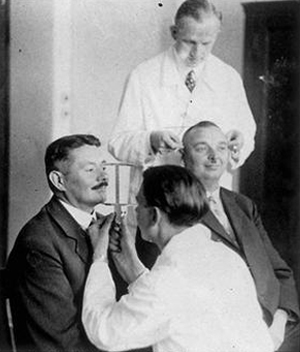
Professor Otmar Freiherr von Verschuer
Otmar von Verschuer (rear) supervises the measurement of two men's head circumference as part of an anthropometric study of heredity.
Born: 16 July 1896, Wildeck, German Empire
Died: 8 August 1969 (aged 73), Münster, West Germany
Citizenship: German
Scientific career
Fields: Human biology, human genetics
Institutions: Kaiser Wilhelm Institute of Anthropology, Human Heredity, and Eugenics, University of Münster
Otmar Freiherr von Verschuer (16 July 1896 – 8 August 1969) was a German human biologist and geneticist, who was the Professor of Human Genetics at the University of Münster until he retired in 1965. A member of the Dutch noble Verschuer family, his title Freiherr is often translated as baron.
He was regarded as a pioneer in the twin methodology of genetics research and in the study of the inheritance of diseases and anomalies.[1] A eugenicist with an interest in racial hygiene, he was an advocate of compulsory sterilization programs in the first half of the 20th century.[2][3] Among his many students was Josef Mengele.
He successfully redefined himself as a geneticist in the postwar era. During the 1950s and 1960s, he was known for research on the effects of nuclear radiation on humans and for his warnings against the possibility of creating "scientifically improved" human beings offered by genetic science.
Verschuer was the director of the Institute for Genetic Biology and Racial Hygiene from 1935 to 1942 and director of the Kaiser Wilhelm Institute of Anthropology, Human Heredity, and Eugenics from 1942 to 1948. From 1951 to 1965, he was Professor of Human Genetics at the University of Münster, where he also served as Dean of the Faculty of Medicine. At Münster, he established one of the largest centers of genetics research in West Germany, and remained one of the world's most prominent genetics researchers until his death. He became Professor Emeritus in 1965; he received numerous memberships in learned societies. In 1952 he was elected President of the German Anthropological Association. His son Helmut von Verschuer was a high-ranking official of the European Commission.
Family
Otmar von Verschuer was born into a noble family originally from Gelderland, Netherlands; the Verschuer family remains prominent in the Netherlands, where it is known as van Verschuer. From birth he held the title of Freiherr (baron), a title that had been granted to several family branches by the Holy Roman Emperor, the Dutch king, and the elector of Hesse. He was mainly of Dutch, German, Estonian/Baltic German, and Swedish descent, and had distant Scottish ancestry. His father Hans von Verschuer was a businessman who owned a mining company, while his mother Charlotte née von Arnold was originally from Estonia; her family was ennobled in Russia in the mid-19th century and was partially resident in Sweden. He was a descendant of the House of Stuart through his 6th great grandmother Brita Stuart, a Swedish noblewoman of Scottish royal descent.[4]
Otmar von Verschuer was the father of Helmut Freiherr von Verschuer (also known as Helmut van Verschuer), a high-ranking official of the European Commission, and the grandfather of the Belgian-German actor, Leopold Freiherr von Verschuer (born 1961 in Brussels).[5]
Early career
Verschuer served in the First World War and had been promoted to first lieutenant by 1918. From 1919, he studied medicine at the University of Marburg. He earned a doctorate in medicine at LMU in 1923 and a habilitation at the University of Tübingen in 1927. In 1927, he became head of department for human genetics at the Kaiser Wilhelm Institute of Anthropology, Human Heredity, and Eugenics.
Nazi era
In 1935, Verschuer became a member of the congregation of the anti-Nazi pastor Otto Fricke, a leading member of the Confessing Church. He also maintained a close friendship with his relative, Adam von Trott zu Solz, a leading resistance figure. Despite his proximity to the Confessing Church, he joined the Nazi Party in 1940, although he wasn't actively involved with politics.
In the late stages of the Second World War, Verschuer directly or indirectly started to use research material obtained in the Auschwitz concentration camp, mainly through his former student Josef Mengele, who served there as a camp physician.[6]
Verschuer was never tried for war crimes despite many indications that he not only was fully cognisant of Mengele's work at Auschwitz, but even encouraged and collaborated with Mengele. In a report to the German Research Council (Deutsche Forschungsgemeinschaft; DFG) from 1944, Verschuer talked about Mengele's assistance in supplying the KWIfA with some "scientific materials" from Auschwitz:
My assistant, Dr. Mengele (M.D., Ph.D.) has joined me in this branch of research. He is presently employed as Hauptsturmführer and camp physician in the concentration camp at Auschwitz. Anthropological investigations on the most diverse racial groups of this concentration camp are being carried out with permission of the SS Reichsführer [Himmler]; the blood samples are being sent to my laboratory for analysis.
Verschuer wrote in the report that the war conditions had made it difficult for the KWIfA to procure "twin materials" for study, and that Mengele's unique position at Auschwitz offered a special opportunity in this respect. In the summer of 1944, Mengele and his Jewish slave assistant Dr. Miklós Nyiszli sent other "scientific materials" to the KWIfA, including the bodies of murdered Gypsies, internal organs of dead children, skeletons of two murdered Jews, and blood samples of twins infected by Mengele with typhus.
He was accepted during the war as a member of the American Eugenics Society, a position he kept until his death.
Post-war career
As the war was drawing to a close in 1945, Verschuer moved the files of the KWIfA into the Western part of Germany, hoping for a more favorable response from the advancing Allied armies than from the advancing Soviet Army. In late 1945 or early 1946, he petitioned the mayor of Frankfurt to allow him to reestablish the KWIfA. However, the commission in charge of rebuilding the Kaiser Wilhelm Gesellschaft decreed that "Verschuer should be considered not as a collaborator, but one of the most dangerous Nazi activists of the Third Reich." The KWIfA was not reestablished.
In 1951, Verschuer was awarded the prestigious professorship of human genetics at the University of Münster, where he established one of the largest centers of genetics research in West Germany. Like many "racial hygienists" of the Nazi period, and many American eugenicists, Verschuer was successful in redefining himself as a genetics researcher after the war, and avoided the taint of his work with Nazi eugenics. Many of his wartime students were similarly appointed to top positions in universities of Erlangen, Frankfurt, Düsseldorf, and Münster.
In his denazification hearing, Verschuer was deemed to be a Nazi fellow traveler (Mitläufer, a relatively mild categorization meaning someone who was neither a supporter or member of the regime nor an active opponent), and fined 600 Reichsmark. He was never prosecuted for his research activities during the war. Leo Alexander who investigated the case concluded that no solid evidence could be found, and considered it likely that Verschuer had destroyed any possibly incriminating material.
During the 1950s and 1960s, Verschuer led major research projects on the effects of nuclear radiation on humans. Deeply religious, he also concerned himself with questions of Christian ethics, and argued that eugenics must be based on human dignity and love for mankind; according to historian Sheila F. Weiss he "turned his back on" Nazi beliefs. In the 1960s he warned against human geneticists trying to create "scientifically improved" human beings.[7]
Verschuer died in 1969 in an automobile accident.
Honours
• 1934: Fellow of the Academy of Sciences Leopoldina
• 1943: Fellow of the Prussian Academy of Sciences
• 1949: Fellow of the Akademie der Wissenschaften und der Literatur
• 1949: Corresponding member of the American Society of Human Genetics
• 1953: Honorary member of the Italian Society of Medical Genetics
• 1955: Honorary member of the Anthropological Society of Vienna
• 1956: Honorary member of the Japanese Society of Human Genetics
• 1959: Corresponding member of the Austrian Academy of Sciences
• 1961: Among the founders of The Mankind Quarterly
Bibliography
• Erbpathologie (Hereditary pathology, 1934).[8]
• Erbbiologie als Unterlage der Bevölkerungspolitik (Hereditary biology as a basis for the population policy). First published in 1933, re-published and modified in 1936.[8]
• Rassenhygiene als Wissenschaft und Staatsaufgabe (Racial hygiene as Science and State function, 1936).[8]
• Leitfaden der Rassenhygiene (Textbook of Racial hygiene, 1944).[8]
• Eugenik. Kommende Generationen in der Sicht der Genetik (Eugenics: Coming Generations in the view of Genetics, 1966).[8]
Notes
Regarding personal names: Freiherr is a former title (translated as Baron). In Germany since 1919, it forms part of family names. The feminine forms are Freifrau and Freiin.
1. Björn M. Felder, Paul J. Weindling, Baltic Eugenics: Bio-Politics, Race and Nation in Interwar Estonia, p. 310
2. Nicholas Wade, "IQ and Heredity: Suspicion of Fraud Beclouds Classic Experiment", Science 26 November 1976: 916–919.
3. D. D. Dorfman, "The Cyril Burt Question: New Findings", Science 29 September 1978: Vol. 201 no. 4362 pp. 1177–1186
4. Niclas von Rothstein (2014), "von Arnold." Ointroducerad adel 2015 : kalender över Ointroducerad adels förening, ISBN 9789163766510
5. Hans W. Geissendörfer, Ediths Tagebuch: Erinnerungen, Essays, Personen-Beschreibungen, p. 115, 1983
6. A display of von Verschauer in relation to Mengele appeared during 2011 in the exhibit "Deadly Medicine: Creating the Master Race" in the Museum of Texas Tech University, Lubbock, Texas.Kerns, William (21 February 2011). "Deadly medicine [photo of von Verschuer appears in the print edition only]". Lubbock Avalanche-Journal. pp. B1, B4. Retrieved 25 February 2011.
7. Über einen faustischen Pakt
8. Westermann, Kühl, Gross (2009), p. 78
Sources
• Westermann, Stefanie; Kühl, Richard; Gross, Dominik, eds. (2009), Medizin und Nationalsozialismus vol. 1: Medizin im Dienst der "Erbgesundheit": Beiträge zur Geschichte der Eugenik und "Rassenhygiene" (English: Medicine and National Socialism, Vol. 1: Medicine at work, the "hereditary health": Contribution to history of Eugenics and "race hygiene"), LIT Verlag Münster, ISBN 978-3643104786
See also
• Nazi eugenics
• Dr Heinrich Gross
References
• Sheila Faith Weiss: After the Fall. Political Whitewashing, Professional Posturing, and personal Refashioning in the Postwar Career of Otmar Freiherr von Verschuer. Isis, Vol. 101 (2010), 722–758.
• Peter Degen, "Racial Hygienist Otmar von Verschuer, the Confessing Church, and comparative reflections on postwar rehabilitation," pp. 155–65 in Jing Bao Nie, Japan´s Medical Wartime Atrocities (London: Routledge&Kegan, 2010)
• Robert N. Proctor, Racial Hygiene: Medicine under the Nazis, Cambridge, MA: Harvard University Press, 1988.
• Paul Weindling, "'Tales from Nuremberg': The Kaiser Wilhelm Institute for Anthropology and Allied medical war crimes policy," in Geschichte der Kaiser-Wilhelm-Gesellschaft im Nationalsozialismus: Bestandaufnahme und Perspektiven der Forschung, ed. Doris Kaufmann, v.2 (Goettingen: Wallstein, 2000), 635–652.
• Katrin Weigmann: "In the name of science. The role of biologists in Nazi atrocities: lessons for today's scientists" in EMBO Reports v.2 #10 (2001), 871–875.
• Eric Ehrenreich, "Otmar von Verschuer and the 'Scientific' Legitimization of Nazi Anti-Jewish Policy," Holocaust and Genocide Studies 2007 21(1):55–72
External links
• Works by or about Otmar Freiherr von Verschuer at Internet Archive
• "In the name of science" EMBO Reports article about KWI scientists' wartime atrocities, with images of Verschuer
• "Skeletons in the Closet of German Science" Deutsche Welle article on Verschuer's research connection to Mengele


